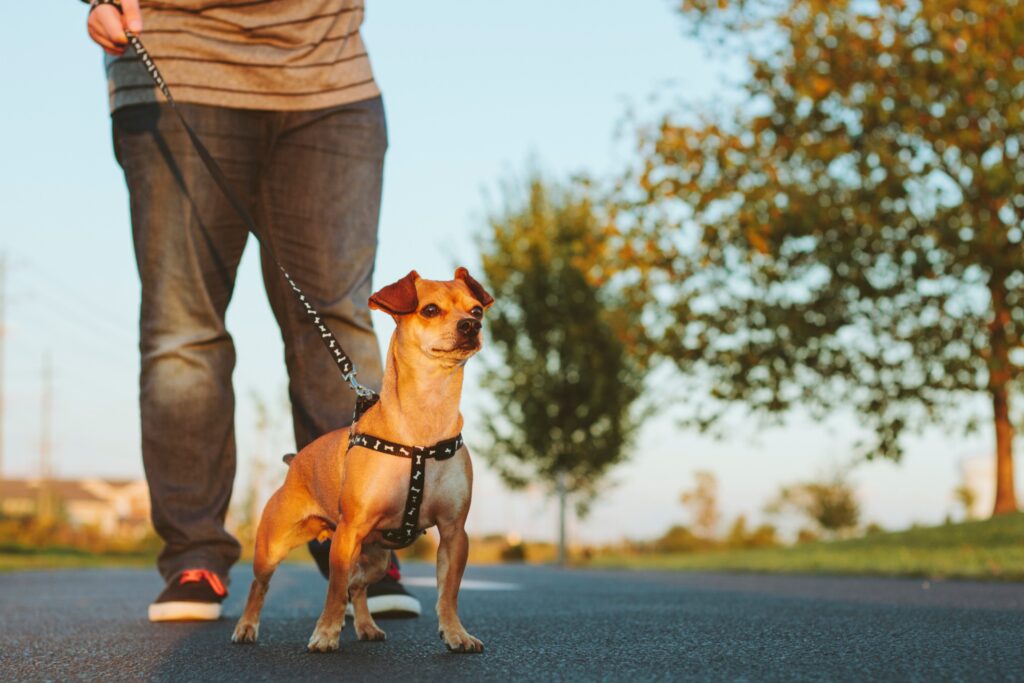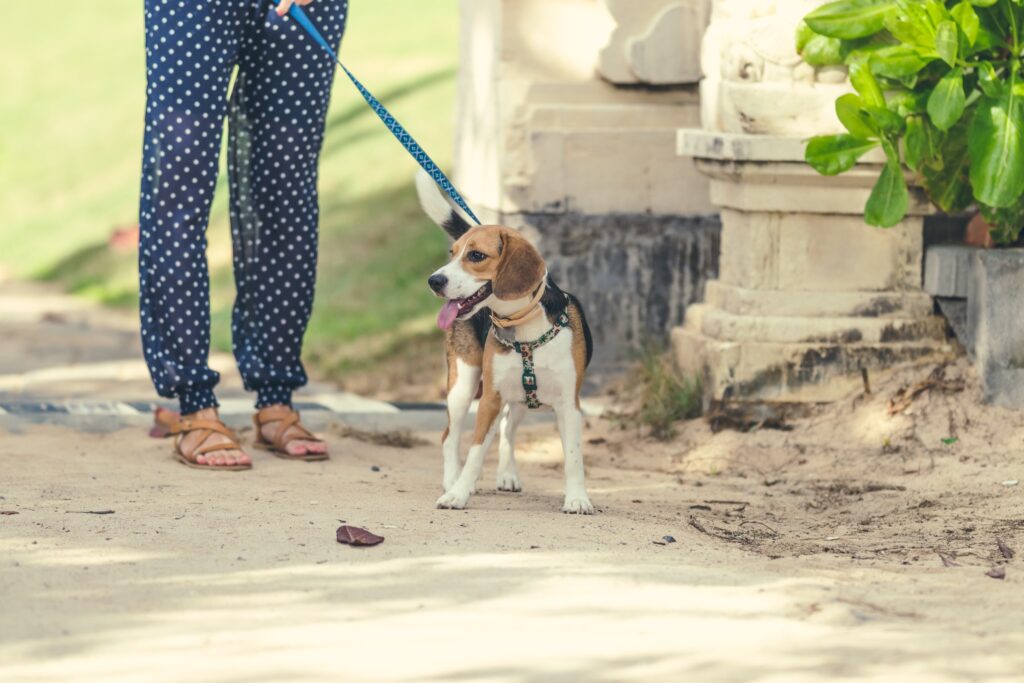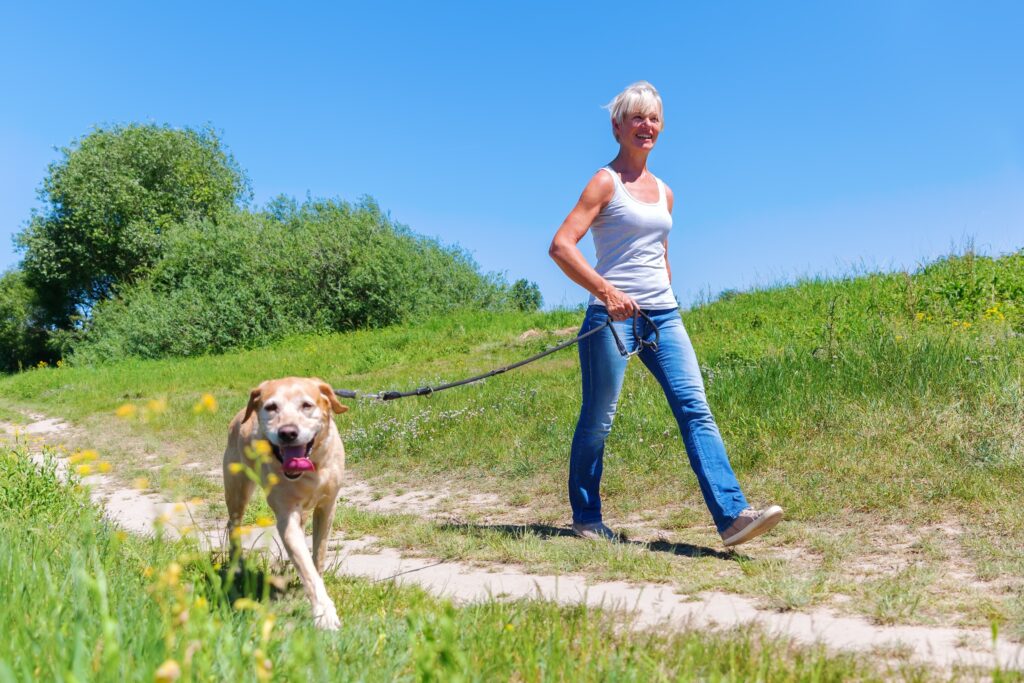Last Updated on June 22, 2024 by Dr. Wendy Wilkins, DVM, PhD
Dog walking is a popular activity that provides numerous physical and mental health benefits. It encourages regular exercise, which is particularly important for seniors to maintain mobility and reduce the risk of chronic diseases.
However, a recent review published in the Journal of the American Veterinary Medical Association (JAVMA)1 has highlighted an increased risk of injuries, especially among older adults, associated with this activity.
The Benefits and Risks of Dog Walking
Walking is an effective way to achieve the recommended daily physical activity, and dog walking can significantly increase exercise levels.
According to the review conducted by Rosa and Buckley (2024)1, there is strong evidence that dog owners tend to be more active than non-owners, with many adopting dogs not only for companionship, but to boost their physical health, reduce blood pressure, and manage weight.
Despite these benefits, the activity is not without risks. Injuries related to dog walking have been rising significantly in recent years, particularly among seniors.

Common Injuries and Their Causes
Falls have been found to be the most common cause of injury among older adults while dog walking. This is not surprising considering that seniors have a higher risk of falls due to age-related changes in balance, strength, and coordination.
Other common injuries include strains or sprains from overexertion, cuts or bruises from leash tangles or bites, and dog-related injuries such as being knocked over by an overly excited pup.
Most injuries involve the upper extremities, such as the fingers, wrists, shoulders, and head. Fractures, sprains, and contusions are common, with traumatic brain injuries also being noted in some cases.
Women over 65 are particularly vulnerable. Factors contributing to this increased risk include decreased bone density, impaired balance, and the physical strength required to handle a pulling dog. Postmenopausal women are more likely to incur a serious injury, such as a broken bone, because of a fall.
Additional studies have reinforced these findings. For instance, a study by Stevens et al. (2009)2 found that nonfatal fall-related injuries associated with dogs and cats accounted for a significant number of emergency room visits in the United States.
Furthermore, Garcia et al. (2015)3 noted that dog ownership in postmenopausal women was associated with higher levels of physical activity, but this increased activity also correlated with a higher risk of injury due to falls and leash-pulling incidents.
Tips for Preventing Dog-Walking Injuries
Dog walking is, and will continue to be, an important reason for dog owners to get out and exercise. However, it is important for seniors in particular to take precautions to avoid potential injuries. Here are some tips to keep in mind:
- Choose the Right Equipment:
- Leash: Use a short, sturdy leash instead of an extendable one. Extendable leashes can allow dogs to gain too much momentum, increasing the risk of falls. Long leashes also increase the risk of entanglement, leading to tripping and falls.
- Harness: Consider using a chest harness instead of a neck collar. This can provide better control and reduce the risk of neck injuries to the dog. A head harness in addition to the chest harness can provide added control of larger dogs.
- Training:
- Invest time in training your dog to walk calmly on a leash. Professional training can significantly reduce leash-pulling behavior.
- Puppy classes are a great way to not only teach both you and your pup to do leash-walking safely, they are also a great socializing opportunity for yourself and your dog.
- Teach basic commands like “sit,” “stay,” and “heel,” which can help manage your dog during walks.
- Be Mindful of Your Surroundings:
- Avoid slippery or uneven surfaces, which can increase the risk of falls.
- Walk in well-lit areas and during daylight hours whenever possible.
- Walk a regular route, and if possible let someone know where you will be and when to expect you back so that if something should happen it will be easier for help to find you.
- Physical Preparedness:
- Ensure you are physically capable of handling your dog. Regular exercise and strength training can help improve your balance and reduce the risk of falls.
- Consult with your healthcare provider before starting or continuing a dog-walking routine, especially if you have any existing health conditions.
- Weather Considerations:
- Be cautious in adverse weather conditions. Ice, snow, and rain can make surfaces slippery. Wearing studded footwear can improve traction in ice and snow.
- In hot weather, walk your dog early in the morning or in the evening to avoid heat-related illnesses. Stay hydrated and take breaks as needed, for both you and your dog.
- Regular Veterinary Check-ups:
- Regular veterinary visits can ensure your dog is healthy and provide early intervention for behaviors that might increase the risk of pulling, such as excessive energy or anxiety.

Suggestions For Veterinarians
In addition to the primary preventive measures discussed, secondary prevention strategies can further improve dog-walking safety for seniors.
For example, veterinarians can create brochures to highlight potential risks of leash walking and offer guidance on proper leash training during routine visits. Including dog behavior questions in clinical histories can prompt discussions on leash training and overall behavior management.
Veterinarians can also take the opportunity to educate clients on the specific risk factors such as the use of extendable leashes. They can advise the client on proper collar and harness fit, and check to make sure they are using a leash length that is appropriate for them and their dog.
Summing Up
While dog walking is a beneficial activity for maintaining physical and mental health, it is important to recognize and minimize the associated risks.
By selecting appropriate equipment, investing in training, and being mindful of physical and environmental factors, seniors can enjoy the benefits of dog walking while reducing the risk of injury.
Regular consultation with healthcare providers and veterinarians can further enhance safety for both the walker and the dog.
By implementing these preventive measures, seniors can continue to reap the health benefits of dog walking without compromising their safety.

[All images used with permission or under licence]
References
- Rosa R, Buckley RE. Leash-related injuries associated with dog walking: an understudied risk for dog owners? J Am Vet Med Assoc. 2024 Apr 5;262(7):973-978. doi: 10.2460/javma.23.11.0608. PMID: 38579750.
- Stevens, J. Nonfatal fall-related injuries associated with dogs and cats—United States, 2001–2006. MMWR Morb Mortal Wkly Rep. 2009;58(11):277–281.
- Garcia, D.O., Wertheim, B.C., Manson, J.E., et al. Relationships between dog ownership and physical activity in postmenopausal women. Prev Med. 2015;70:33–38.

